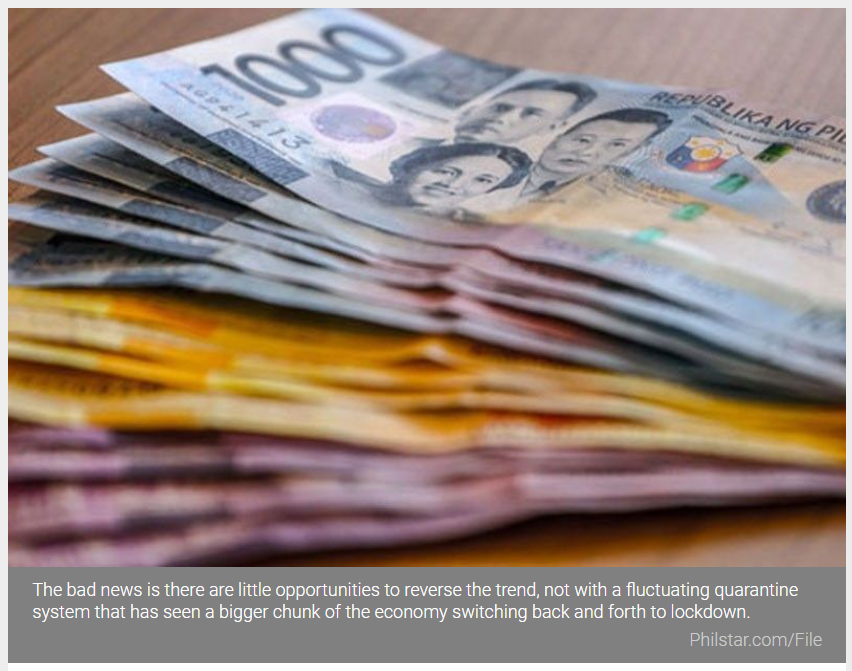Philippines: CREATE costs turn deficit outlook bleak after March high
MANILA, Philippines — The Duterte administration’s budget deficit swelled to its widest monthly level this year so far in March, hurt by a latest collapse in revenues likely to persist as the government awaits returns from lower tax rates while the pandemic bill explodes without signs of a compelling economic revival.
The bad news is there are little opportunities to reverse the trend, not with a fluctuating quarantine system that has seen a bigger chunk of the economy switching back and forth to lockdown. Coupled with a tax cut for companies supposedly to prompt them to hire and invest, the government is only bound to incur wider revenue shortfalls in the coming months.
In March alone, the budget gap soared to P191.4 billion, over twice the level last year when the archipelago was first placed in lockdown, the Bureau of the Treasury reported on Tuesday.
That ballooned the deficit to P321.5 billion in the first quarter compared with just P86.2 billion same period a year ago. “It’s hard to see a pick up if rolling quarantines continue,” Ruben Carlo Asuncion, chief economist at Union Bank of the Philippines, said when sought for comment.
“Revenues may not recover until confidence of firms and consumers consistently return,” he added in a text message.
A deficit happens when revenues generated fall short of spending and in March, that was more obvious with a 17.37% year-on-year drop in state earnings. That marked the largest fall since May last year when revenues sank 52.2% annually, although figures would show it was more a result of plunge in non-tax revenues.
On the other hand, expenditures that struggled to pick up last year have continued to gain ground, up 22.3% in March from 37.3% in February and just 1.2% in January.
Treasury attributed the revenue slip to high base effects propelled by last year’s remittance of dividends from government firms. This means that because of that one-time event, March 2020’s revenues were unusually high than normal, and did not happen this year. Finance Secretary Carlos Dominguez III said Monday the state is looking into sourcing bigger remittances from government-owned and –controlled corporations.
Reporting of dividends happen annually, although their exact schedule differ each year. This should not be a cause for concern, more than the impending decrease in corporate taxes this month when the deadline to pay up levies coincided with the enforcement of the Corporate Recovery and Tax Incentives for Enterprises (CREATE) Act. CREATE reduces corporate tax rates to 25% or 20%, depending on firm size, from 30% in hopes savings will be funneled toward recovery.
“With the stark difference in economic activity in March 2020 vs. March 2021, revenue collection dropped off significantly, a trend we will likely continue to track as corporate taxes remit at lower tax rates,” Nicholas Antonio Mapa, senior economist at ING Bank in Manila, said in an email.
A top concern though is the lingering economic weakness evident on the ground. More recently, that was exacerbated by a return to tighter lockdowns in Metro Manila and four nearby urban areas, which collectively account for over half of gross domestic product. With consumers still largely prevented from going out, and some enterprises still closed, tax receipts are bound to fall, compounding the impact of lower tax rates.
“The more structural and sustainable solution is further reopening of the economy that increases the capacity, production, sales, income, employment of many businesses and industries…,” Michael Ricafort, chief economist at Rizal Commercial Banking Corp., said in a commentary.
To be fair, a larger deficit is not something the government did not expect. At the onset, economic managers already programmed the deficit to hit P1.78 trillion by yearend, wider than the P1.37 trillion a year ago that fell below expectations. Even while Mapa does not expect spending strength to be sustained, he said a slide in revenue would hit so hard, the deficit has no choice but to widen further.
“One strategy would be to force the economy to reopen in a bid to revive business and in turn raise revenues, but this leaves the general population susceptible to the reinstatement of lockdowns just as we experienced this year,” Mapa said.
Source: https://www.philstar.com/business/2021/04/27/2094129/create-costs-turn-deficit-outlook-bleak-after-march-high


 Thailand
Thailand




